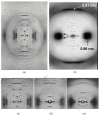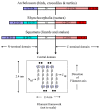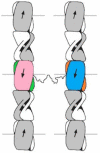Structures of the ß-Keratin Filaments and Keratin Intermediate Filaments in the Epidermal Appendages of Birds and Reptiles (Sauropsids)
- PMID: 33920614
- PMCID: PMC8072682
- DOI: 10.3390/genes12040591
Structures of the ß-Keratin Filaments and Keratin Intermediate Filaments in the Epidermal Appendages of Birds and Reptiles (Sauropsids)
Abstract
The epidermal appendages of birds and reptiles (the sauropsids) include claws, scales, and feathers. Each has specialized physical properties that facilitate movement, thermal insulation, defence mechanisms, and/or the catching of prey. The mechanical attributes of each of these appendages originate from its fibril-matrix texture, where the two filamentous structures present, i.e., the corneous ß-proteins (CBP or ß-keratins) that form 3.4 nm diameter filaments and the α-fibrous molecules that form the 7-10 nm diameter keratin intermediate filaments (KIF), provide much of the required tensile properties. The matrix, which is composed of the terminal domains of the KIF molecules and the proteins of the epidermal differentiation complex (EDC) (and which include the terminal domains of the CBP), provides the appendages, with their ability to resist compression and torsion. Only by knowing the detailed structures of the individual components and the manner in which they interact with one another will a full understanding be gained of the physical properties of the tissues as a whole. Towards that end, newly-derived aspects of the detailed conformations of the two filamentous structures will be discussed and then placed in the context of former knowledge.
Keywords: X-ray fiber diffraction; corneous ß-proteins; keratin intermediate filaments.
Conflict of interest statement
The author declares that he has no known competing financial interests or personal relationships that could have appeared to influence the work reported in this paper.
Figures












Similar articles
-
Review: Evolution and diversification of corneous beta-proteins, the characteristic epidermal proteins of reptiles and birds.J Exp Zool B Mol Dev Evol. 2018 Dec;330(8):438-453. doi: 10.1002/jez.b.22840. Epub 2019 Jan 14. J Exp Zool B Mol Dev Evol. 2018. PMID: 30637919 Review.
-
Sauropsids Cornification is Based on Corneous Beta-Proteins, a Special Type of Keratin-Associated Corneous Proteins of the Epidermis.J Exp Zool B Mol Dev Evol. 2016 Sep;326(6):338-351. doi: 10.1002/jez.b.22689. Epub 2016 Aug 10. J Exp Zool B Mol Dev Evol. 2016. PMID: 27506161 Review.
-
Filamentous Structure of Hard β-Keratins in the Epidermal Appendages of Birds and Reptiles.Subcell Biochem. 2017;82:231-252. doi: 10.1007/978-3-319-49674-0_8. Subcell Biochem. 2017. PMID: 28101864 Review.
-
Cornification in reptilian epidermis occurs through the deposition of keratin-associated beta-proteins (beta-keratins) onto a scaffold of intermediate filament keratins.J Morphol. 2013 Feb;274(2):175-93. doi: 10.1002/jmor.20086. Epub 2012 Oct 15. J Morphol. 2013. PMID: 23065677
-
The molecular organization of the beta-sheet region in Corneous beta-proteins (beta-keratins) of sauropsids explains its stability and polymerization into filaments.J Struct Biol. 2016 Jun;194(3):282-91. doi: 10.1016/j.jsb.2016.03.004. Epub 2016 Mar 7. J Struct Biol. 2016. PMID: 26965557
Cited by
-
Keratinous and corneous-based products towards circular bioeconomy: A research review.Environ Sci Ecotechnol. 2024 Jun 28;22:100444. doi: 10.1016/j.ese.2024.100444. eCollection 2024 Nov. Environ Sci Ecotechnol. 2024. PMID: 39183760 Free PMC article. Review.
-
The Caenorhabditis elegans cuticle and precuticle: a model for studying dynamic apical extracellular matrices in vivo.Genetics. 2024 Aug 7;227(4):iyae072. doi: 10.1093/genetics/iyae072. Genetics. 2024. PMID: 38995735 Free PMC article. Review.
-
The long protostomic-type cytoplasmic intermediate filament (cIF) protein in Branchiostoma supports the phylogenetic transition between the protostomic- and the chordate-type cIFs.Protoplasma. 2023 Nov;260(6):1493-1500. doi: 10.1007/s00709-023-01865-3. Epub 2023 May 20. Protoplasma. 2023. PMID: 37209173
References
-
- Wu P., Ng C.S., Yan J., Lai Y.C., Chen C.K., Lai Y.T., Wu S.M., Chen J.J., Luo W., Widelitz R.B., et al. Topographical mapping of α- and β-keratins on developing chicken skin integument: Functional interaction and evolutionary perspectives. Proc. Natl. Acad. Sci. USA. 2015;122:E6770–E6779. doi: 10.1073/pnas.1520566112. - DOI - PMC - PubMed
Publication types
MeSH terms
Substances
LinkOut - more resources
Full Text Sources
Other Literature Sources

